By what sorcery do some artworks become more famous than others? How do some paintings, by the same artist and from the same period, end up reaching worldwide fame, while others are forgotten by the majority? More simply, why are some artworks more famous than others?
Today, Artmajeur looks at 8 unjustly neglected paintings that have nothing to envy the masterpieces celebrated in the world's greatest museums.
1. The Sower (after Millet), Arles, June 1888
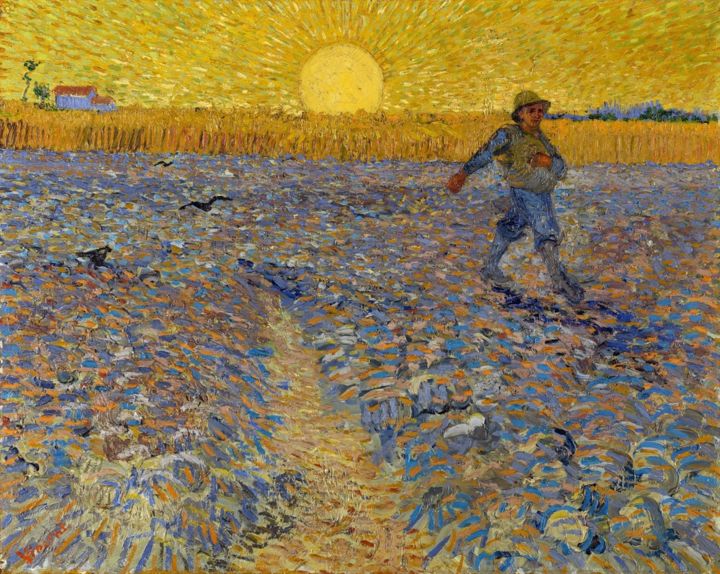 The Sower (after Millet), Arles, June 1888. Otterlo, Kroller-Muller Museum (Netherlands).
The Sower (after Millet), Arles, June 1888. Otterlo, Kroller-Muller Museum (Netherlands).
Van Gogh knew how to paint the Starry Night like no one else, everyone knows that. What is less well known is that he was also very good at representing the Sunny Day!
Done in June 1888 during his luminous stay in Arles, this artwork is a real golden nugget. Inspired by an artwork from his model at the time, the realist painter Jean-François Millet, this painting features a sower, hard at work under the bright sun of the South of France. While one can easily guess the sorrow on the face of the farm worker depicted by Millet, it's not what stands out the most in this new version signed by Van Gogh. Here, the colors sing, the sky accompanies them with its most beautiful score, and the painful and repetitive movements of the sower are transformed into a skillfully choreographed gesture.
2. Skeleton with a Burning Cigarette, Antwerp (Netherlands), 1886.
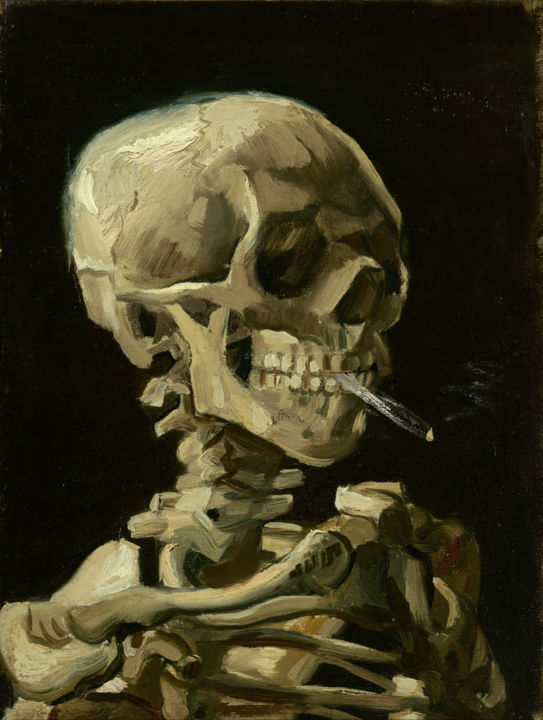 Skeleton with a Burning Cigarette, Antwerp (Netherlands), 1886. Van Gogh Museum, Amsterdam (Netherlands).
Skeleton with a Burning Cigarette, Antwerp (Netherlands), 1886. Van Gogh Museum, Amsterdam (Netherlands).
Done in 1886 when Van Gogh was at the Academy of Fine Arts in Antwerp, this dark artwork is certainly one of the most surprising of his career. At that time, anatomical drawings were a must for art students. It was much less conventional to make paintings of them. The addition of a cigarette between the mandibles of the skeleton reveals the artist's irreverence towards this classical exercise.
If we know Van Gogh today for his colorful and luminous paintings, his earlier artworks were however marked by a particular darkness, as evidenced by this skeleton that deals without concessions with the delicate theme of death. Halfway between the macabre and the satirical, this inverted memento-mori undoubtedly conceals another reading grid: the human attitude of this skeleton testifies to a certain arrogance in the face of death, like a predestination for an artist who, although he died in the prime of life, left his mark on the history of art thanks to his creative genius exacerbated by the consumption of more or less harmful substances.
3. The Red Vineyard, Arles, 1888.
 The Red Vineyard, Arles, 1888. Pushkin Museum of Fine Arts, Moscow (Russia).
The Red Vineyard, Arles, 1888. Pushkin Museum of Fine Arts, Moscow (Russia).
Created in Arles in 1888, this is the only artwork Van Gogh sold publicly during his lifetime. In this composition, Van Gogh describes the labor of farmers in the Arles countryside during the harvest period. Avant-garde, Fauvist before its time, this painting is a mixture of complementary colors: the yellow light confronts the purple shadows, and the red vines oppose the bluish tone of the muddy earth. Since 1906, the artwork has never left Russia: it' s on display in the famous Pushkin Museum in Moscow.
4. Portrait of Père Tanguy, Paris, 1887-1888.
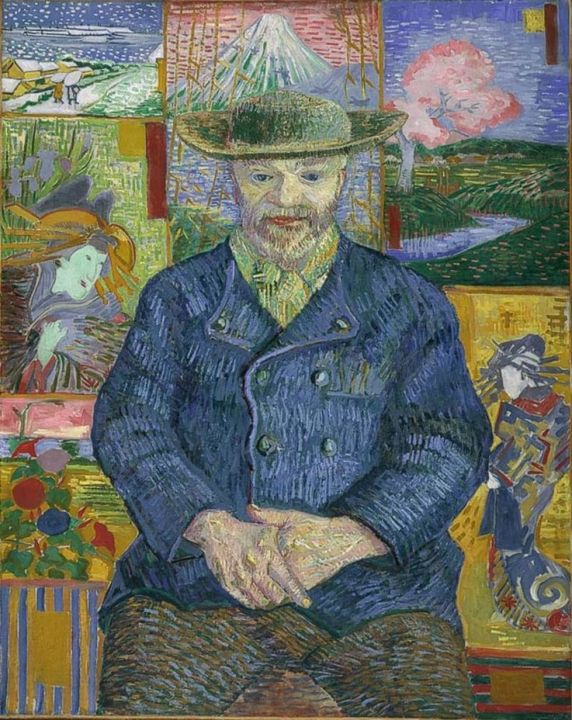 Portrait of Père Tanguy, Paris, 1887-1888. Rodin Museum, Paris (France).
Portrait of Père Tanguy, Paris, 1887-1888. Rodin Museum, Paris (France).
But who is this friendly and cute old man, surrounded by beautiful Japanese prints?
Père Tanguy was a friend of famous painters before they became famous. He was a color merchant in Paris during the years 1860 to 1890 and was very close to the Impressionists and to all the artists who had a bellyful of color. In his store, the most creative personalities of the time followed one another: Van Gogh (of course), but also Monet, Renoir, Cézanne, Toulouse-Lautrec, Pissarro, or Gauguin to name but a few. Much more than a supplier of materials, he was also an admirable collector and art dealer, who understood before anyone else the enormous artistic interest of the impressionist and post-impressionist movements. Here, Van Gogh depicts him as he sees him: his good nature transcends the canvas, and a broad palette of color blooms in the background. Finally, the artist offers a synthesis of the character and function of this important friend.
5. Weaver at his Loom, Nuenen (Netherlands), May 1884.
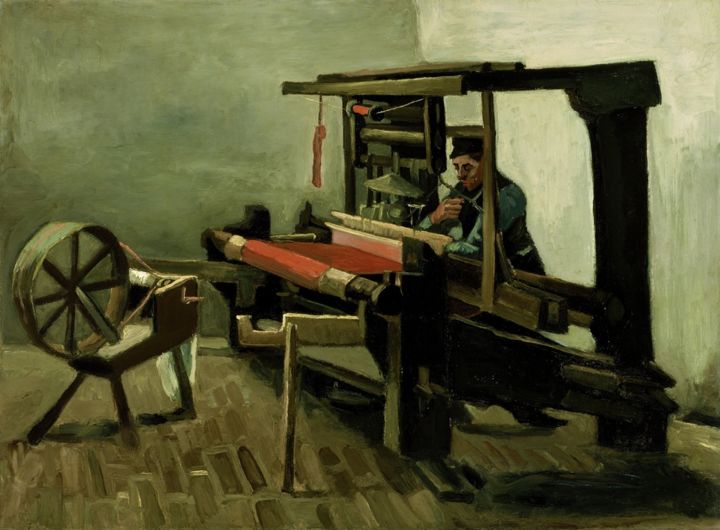 Weaver at his Loom, Nuenen (Netherlands), May 1884. Museum of Fine Arts, Boston (US).
Weaver at his Loom, Nuenen (Netherlands), May 1884. Museum of Fine Arts, Boston (US).
As we saw earlier with the artwork The Sower, inspired by a painting made by Millet, Van Gogh was a fervent admirer of the realist movement, represented by artists such as Gustave Courbet, Millet or Honoré Daumier. This artistic movement was characterized by a quest for reality, long forgotten in classical academic painting and romanticism, which were limited to describing mythological or religious scenes, in a constant search for perfection, far from the realities of the time. Vincent Van Gogh, like his models Courbet and Millet, shows true feelings for the hard-working people and their crushing tasks. When he produced this artwork, the artist was still in the Netherlands, amid his "dark period".
He had just finished several novels by Emile Zola, an illustrious writer known for his crude and sometimes sordid descriptions of the working-class world at the end of the 19th century (Nana, Germinal, L'Assommoir...). The weavers are part of these poor workers, condemned to labor and paid derisory wages. The general atmosphere and the colors are as dark as the psychology of the main subject, the weaver: a perfect osmosis between the subject, the composition, the artist's will, and his time. Impressive!
6. Prisoners' Round (after Gustave Doré), Saint-Rémy, 1890.
 Prisoners' Round (after Gustave Doré), Saint-Rémy, February 1890. Pushkin Museum of Fine Arts, Moscow (Russia).
Prisoners' Round (after Gustave Doré), Saint-Rémy, February 1890. Pushkin Museum of Fine Arts, Moscow (Russia).
Done while Van Gogh was a resident of a mental institution in Saint-Rémy-de-Provence, this artwork can only be interpreted in terms of his own confinement. When he arrived at Saint-Rémy, Vincent was exhausted: he had just gone through a major crisis that had taken half of his ear off, and the inhabitants of Arles had signed a petition to have him committed, no longer able to bear his sordid and repetitive behaviour. This painting, based on an engraving by Gustave Doré, is one of the (very) few genre scenes executed by Vincent van Gogh.
Despite the jerky lines characteristic of his artwork, the artist also offers us beautiful geometric prowess, as if to intensify claustrophobic feeling of the viewer. The floor is rectangular, the walls as well, and in the center of the composition: this round of stooped prisoners, hands behind their backs or in their pockets, as if captive to the three civil servants that we recognize by their hats on the right side. Like most of his artwork, the choice of this subject is not random, but interpretations can be as multiple as subjective... Was Vincent aware of the usefulness of his internment? Was he suffering from the look of others, of the society? Did he see himself as the victim of a collective masquerade, transferring his feelings through the features of the man in the center of the canvas, taller, straighter than the others, who looks at the viewer as if he was aware of the futility of his existence?
7. Bridge in the Rain (after Hiroshige), Paris, Sept-Oct 1887.
 Bridge in the Rain (after Hiroshige), Paris, Sept-Oct 1887. Van Gogh Museum, Amsterdam (Netherlands).
Bridge in the Rain (after Hiroshige), Paris, Sept-Oct 1887. Van Gogh Museum, Amsterdam (Netherlands).
Surprising for a painting by Van Gogh, isn't it? It was in Paris that the artist made this copy of a Japanese print by Hiroshige. This artistic medium, traditional in Asia, was discovered only very late by French painters, because of an intense cultural closure of Japan to the rest of the world, which ended in the mid-1850s.
Like Claude Monet or Edgar Degas, Van Gogh quickly fell under the spell of Far Eastern art. It was his brother Theo, a renowned art dealer, who first confronted him with these colorful prints. Quickly, Vincent collected them, and was inspired by them to invigorate his palette and compose his paintings.
A passionate admirer, he would introduce the pieces of his collection into several of his artworks, such as in the background of the Portrait of Père Tanguy or behind his Self-Portrait with the Severed Ear.
8. At Eternity's Gate, Saint-Rémy-de-Provence, 1890.
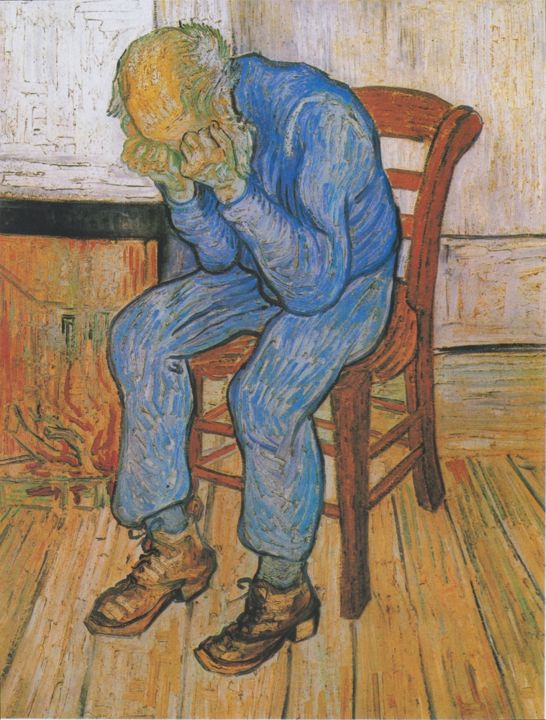 At Eternity's Gate, Saint-Rémy-de-Provence, 1890. Otterlo, Kroller-Muller Museum (Netherlands).
At Eternity's Gate, Saint-Rémy-de-Provence, 1890. Otterlo, Kroller-Muller Museum (Netherlands).
To end this ranking with sensitivity and poetry, here's one of Vincent van Gogh's most enigmatic artwork. Entitled "At Eternity's Gate”, this painting of a stooped old man, his head buried in nervous hands, sounds like a strange premonition. Like most of his works, this painting deals with the complex subject of life, oscillating like the painter's mind between awkward fragility and mastered power.
A premonition? Made in 1890 in Saint-Rémy-de-Provence, shortly before the artist's death, the title of this artwork sounds like a bad omen. At that time, Vincent van Gogh was on the verge of collapse: after his many crises in the South of France, he moved to Auvers-sur-Oise (near Paris), following the advice and concerns of his brother Theo. He's worn out. Like the boots and the suit of the old man. He feels himself wavering, ready to collapse. Like this unstable chair on the verge of breaking, like this elderly man, overwhelmed by his emotions, on the verge of giving up. The darkness of his existence, the darkness of his life tinged with excess and sadness, can now give way to the light that he carries within him eternally.
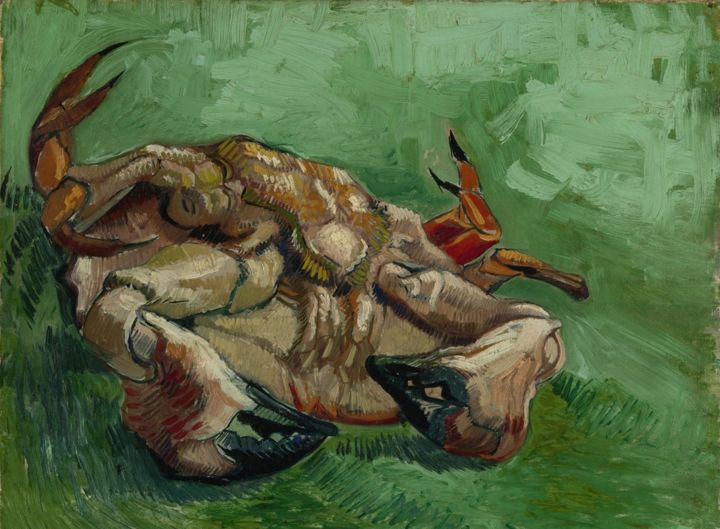
Vincent van Gogh, A crab on its back, 1888. Van Gogh Museum, Amsterdam.
Vincent van Gogh has well earned his place in the pantheon of art history legends. Celebrated throughout the world, his decadent life trajectory contributes to his immense fame.
Dark in his mind but luminous in his paintings, his life and artworks tell us about the contradictions of existence: a painter of fulfillment and solitude, of nostalgia and despair, of closeness and distance, of love and turmoil, of harmony and disorder, of duration and instability... Van Gogh loved the world and life, even though his love remained unfulfilled. He suffered because of this world and was torn apart by it.
He created with his art a new universe just for him, full of colors and movements, which contained everything he knew about existence, without pretension or arrogance.
"Either this man will go mad, or he will leave us far behind him.” - Camille Pissarro.

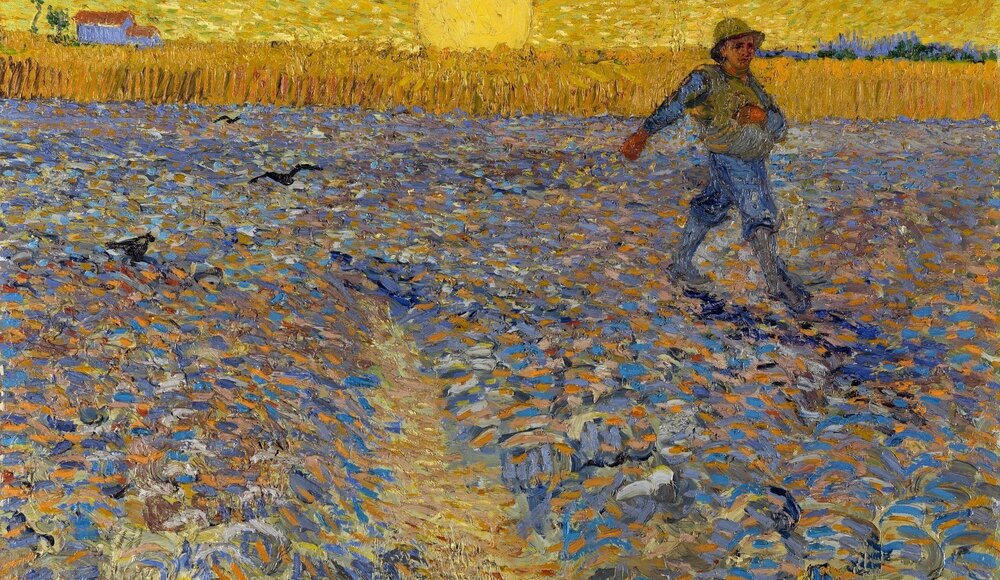
 Bastien Alleaume
Bastien Alleaume